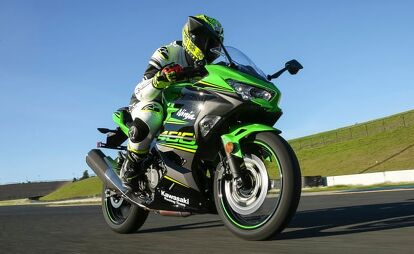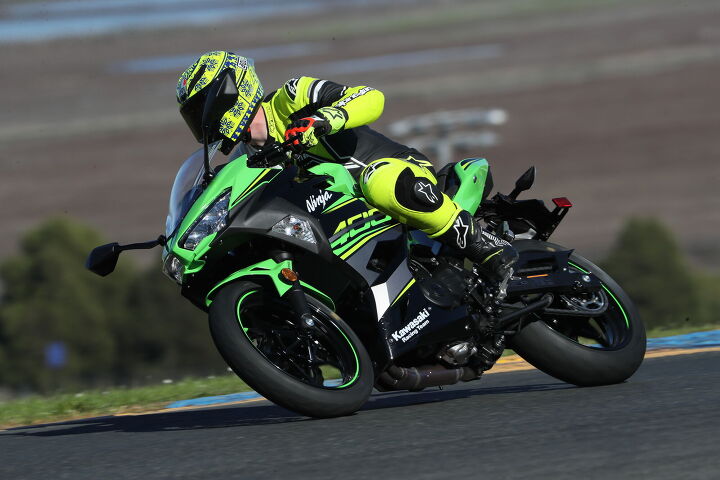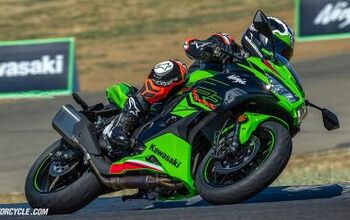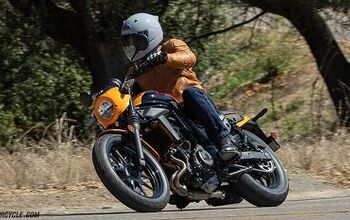2018 Kawasaki Ninja 400 First Ride Review

Kawasaki places itself atop the new lightweight sportbike category
Kawasaki may have just found the sweet spot with its new Ninja 400. At a glance, the new motorcycle has undergone a substantial weight reduction treatment, a displacement boost of 103cc, and a sexy styling redesign – all while remaining at the exact same price point. Non-ABS models start at $4,999 while ABS is an additional $300. Kawasaki was out for blood when it went back to the drawing board for its new entry-level motorcycle.
2018 Kawasaki Ninja 400
| Engine | 18.25/20 |
| Suspension/Handling | 13.0/15 |
| Transmission/Clutch | 9.0/10 |
| Brakes | 7.0/10 |
| Instruments/Controls | 3.5/5 |
| Ergonomics/Comfort | 8.5/10 |
| Appearance/Quality | 8.5/10 |
| Desirability | 8.5/10 |
| Value | 9.0/10 |
| Overall Score | 85.25/100 |
2018 Kawasaki Ninja 400: Exclusive Dyno Run And Measured Weight!
When Kawasaki started to feel the stark competition from bikes like Yamaha’s R3 and KTM’s RC390, they got to work in order to “take back what was theirs,” according to Kawi. That would be the lightweight entry-level sportbike category. With one look at the side by side spec chart, it’s pretty obvious they have done so. After spending a day riding the new Ninja 400 on the winding back roads of Sonoma County and a day of spinning laps at Sonoma Raceway, I am here to report that the 2018 Kawasaki Ninja 400 will be a force to be reckoned with in the lightweight sportbike class.
So, where to start…
Engine: More CC’s, please
Ah, the age-old-adage: There’s no replacement for displacement. While this isn’t always the case, maybe it is more often than not. Kawasaki has boosted the cubic centimeters of its smallest Ninja by 103cc, putting it atop the spec chart when side by side with its classmates. Still a parallel-twin, bore and stroke are increased to 70.0 x 51.8 while compression ratio is bumped to 11.5:1 from 10.6:1 found in the 300.
Engine performance revisions can be seen throughout, including larger diameter head pipes at 31.8mm, a lighter flywheel, more precise tuning allowing for the elimination of sub throttles, lighter forged camshafts, optimized intake and exhaust valves, a new piston with reduced squish and a flatter crown which is also made to be lighter thanks to the oil jets cooling it from below. The cylinder is also sleeveless and uses plated bores.
The radiator has also been redesigned to better direct heat away from components the rider will come into contact with, all while using no new parts says Kawasaki.
Also attributing to the not-so-wee Ninja’s new-found performance is the larger 5.8-liter airbox with a new downdraft intake which provides the most direct path of air into the cylinder. This creates a more efficient intake system. The intake funnels themselves are different heights allowing Kawasaki to tune out most dips in the torque curve. Kawasaki says this has been especially important to improved engine performance at high rpm. The airbox was also engineered with more rigidity at the top to eliminate unwanted noise, while still delivering a clear intake note which was present in the best way at high rpm at Sonoma Raceway.
As we can see on our exclusive dyno run of the Ninja 400, the torque curve is impressively flat, peaking at 25 lb-ft of torque at 8,000 rpm. Perhaps more notably, is the fact that 20 lb-ft are available just under 4,500 rpm. Horsepower is also substantially increased from the previous Ninja, as well as the competition, with 44 hp available at 10,000 rpm.
Beginner-Ish Sportbike Shootout + Video
The transmission has also undergone some revision. Close gear ratios and the assist clutch make flipping through gears a breeze, while the slipper function will prevent the rear tire from hopping or skidding during aggressive or accidental downshifts. Kawasaki says the pull at the clutch lever has been reduced by 20% which may be welcomed on the street; however there were times during our track day when it was difficult to feel the engagement point.
Handling: Fully Flickable
To say the Kawasaki Ninja 400 is maneuverable would maybe be the understatement of the year. As I picked the bike up off of its kickstand it became clear just how lightweight the Ninja 400 was. A few corners later it was apparent how much fun I was about to have for the next two days. The usable mid-range power, light clutch pull, and ease of handling make for a fun and unintimidating entry-bike for those looking to begin their foray into motorcycling.
Let’s take a look at how Kawasaki made an already agile motorcycle into a razor-sharp, apex-mauling, corner-killing, Ninja.
When considering the power-to-weight ratio of motorcycles, dropping 15 lbs provides a substantial boost in performance. When we had the Ninja 400 on the dyno we also had a chance to weigh it. Full of 3.7 gallons of fuel, the 2018 Kawasaki Ninja 400 with ABS weighs 366 lbs. The last Ninja 300 we tested, with a 4.5-gallon tank, weighed 381 lbs, so we’re looking at about a 10-lb drop in real weight.
Although I touched on the engine’s weight savings earlier in this article, weight reducing efforts can be found throughout. The new Ninja 400 is built around a trellis-style frame derived from Kawi’s work on the Ninja H2, which adds rigidity while reducing weight. The rigid-mounted engine is also now used as a stressed member, with an aluminum swingarm mounting plate bolted to the back of the engine. This all leads to added stability and less weight.
A quick look at the Ninja 400’s new chassis dimensions also allude to the nimbler character of the 2018 model. The overall wheelbase has been shortened by 1.4 inches, while the steering angle has been decreased by 2.4 degrees putting rake and trail at 24.7°/3.6 in. Seat height has been kept the same at 30.9 inches. The rather upright “clip-ons” set the handlebars back toward the rider by 15mm from the previous model, while the footpegs have been moved 9mm backward.
All things Kawasaki on Motorcycle.com
The suspension has also been upgraded with a non-adjustable 41mm Showa fork from the Ninja 300’s 37mm tubes. A KYB rear shock with a new Uni-Trak linkage is now used out back with five-way preload adjustment. While the suspension is somewhat soft, I never had any bottoming issues, and it soaked up imperfections on the street quite nicely. On the track, stiffer suspension would be preferred, yet it worked well enough for us to thoroughly enjoy the bikes at Sonoma Raceway.
Kawasaki has also upgraded the Ninja’s stopping power up front to a single 310mm rotor clenched by a dual-piston Nissin caliper, while the rear rotor remains 220mm with a single-piston caliper. Although braking power was adequate, it became one of the few things most journalists said they would change first if track-duty was the assignment. Steel braided brake lines and a set of racing brake pads would likely fix the sponginess and soft initial bite. On the street, it’s not so much a problem. I did overhear other much faster journalists complain about brake fade (cough* Ari Henning *cough* lap record holder at Sonoma Raceway in the 300 class *cough). I didn’t have that issue.
While revising the entire motorcycle, Kawasaki didn’t forget the tires. The Ninja 400 now uses Dunlop Sportmax GPR300 rubber, which provided good grip on the street in dry and damp conditions and wasn’t bad at Sonoma Raceway either.
Style for miles
Since 2008, Kawasaki has done a great job at making its entry-level motorcycles look much more like their larger displaced siblings. For 2018 Kawasaki has continued with styling that is undeniably Ninja.
From the KRT graphics (a $500 upgrade that includes ABS), to the trellis-type frame and tail’s triple-peak motif, the Ninja 400 shares styling and spirit with its bigger bros. LED lighting is found throughout on the Ninja, giving it that premium motorcycle feel. As mentioned previously, the triple-peak motif tail section and small chin spoilers on the bottom of the front cowl were derived from the Ninja H2.
The new five-spoke wheels look slick and are said to be lighter than the previous version.
The cockpit also has refined feel without loose cables or wires hanging around obtrusively, rather everything is well bound and routed neatly out of the way. The dash also looks great while providing a decent amount of information with the gear-selection indicator front and center. In harsh sunlight, the screen can be rather difficult to read.
The Verdict
There seems to be some confusion about the 2018 Kawasaki Ninja 400’s place in the market and Kawi’s line-up. First, Kawasaki will no longer produce the Ninja 300. A lot of folks seemed to think it would continue the 300, but this is not the case. The 400 is now Kawasaki’s smallest sportbike.
Secondly, this isn’t a bike you’ll get tired of in a week! There are so many comments on Kawasaki’s social media channels coming from guys saying things like: Smallest bike I would suggest for a beginner is a 600, or condescending remarks like, Who’s buying these cute lil things. What happened to men? … Those are real comments from Kawasaki’s Facebook page on the promotional video with Tom Sykes and Jonathan Rea. While I would like to go on a rant about this, I’m going to leave it at that and let you folks duke out your feelings about it in the comments section.
Final thoughts on the Ninja 400: It’s a more versatile, unintimidating lightweight sportbike that motorcyclists can grow with. The Ninja 400 would be an easy first motorcycle that you could get into track days with as well. To me, and many others who have ridden the 400, the boost in displacement feels just right. You have easy-to-use mid-range power that comes on strong without being intimidating, incredibly light and precise handling, and styling for days. And guess what?! They are in dealerships now, so seek out your local dealer or demo day and have a look for yourself.
What do you think about the increasing displacement of the lightweight sportbike class? Let us know in the comments section. Also, if there is anything I haven’t addressed in this article that you are curious about, leave a comment and I will get you an answer as soon as possible.
2018 Kawasaki Ninja 400
+ Highs
- Incredibly lightweight handling
- Class-leading horsepower
- Updated or upgraded at every turn while coming in at the same MSRP of the previous model
– Sighs
- Braking performance could benefit from the aftermarket
- Taller riders will want more seat room
- Gauges are difficult to see in bright sunlight
In Gear
Helmet: AGV Corsa (No longer in production)
Jacket: Dainese Super Speed Textile Jacket
Pants: Dainese Over Flux Overpant
Gloves: Racer Gloves Sprint
Boots: Alpinestars SMX Plus Boot
Helmet: AGV Corsa (No longer in production)
Suit: Alpinestars GP Plus V2 Leather Suit
Gloves: Alpinestars Supertech Glove
Boots: Alpinestars SMX Plus Boot
Back Protector: Dainese Manis D1
2018 Kawasaki Ninja 400 Specifications | |
|---|---|
| MSRP | Non-ABS: $4,999 ABS: $5,299-$5,499 |
| Engine Type | Liquid-cooled, 4-stroke Parallel Twin |
| Displacement | 399 cc |
| Bore and Stroke | 70.0 x 51.8 mm |
| Compression ratio | 11.5:1 |
| Valve system | DOHC, 8 valves |
| Horsepower | 44 hp at 10000 rpm (Measured) |
| Torque | 25.0 lb-ft. at 8000 rpm (Measured) |
| Fuel system | Fuel injection: ø32 mm x 2 |
| Ignition | Digital |
| Starting | Electric |
| Lubrication | Forced lubrication, wet sump |
| Transmission | 6-speed, return |
| Final drive | Chain |
| Clutch | Wet multi-disc, manual |
| Frame | Trellis, high-tensile steel |
| Front Suspension | ø41 mm telescopic fork with 4.7 inches travel |
| Rear Suspension | Bottom-Link Uni-Trak, gas-charged shock with adjustable preload with 5.5 inches travel |
| Front Tire | 110/70R17 M/C 54H |
| Rear Tire | 150/60R17 M/C 66H |
| Front Brake | Single semi-floating ø310 mm petal disc with single balanced actuation dual-piston caliper |
| Rear Brake | Single ø220 mm petal disc with dual-piston caliper |
| Caster (rake) | 24.7° |
| Trail | 3.6 inches |
| Steering angle (left/right) | 35°/ 35° |
| Overall length | 78.3 inches |
| Overall width | 28.0 inches |
| Overall height | 44.1 inches |
| Wheelbase | 53.9 inches |
| Ground clearance | 5.5 inches |
| Seat height | 30.9 inches |
| Curb Weight | 366 pounds (Measured) |
| Fuel capacity | 3.7 gallons |

Ryan’s time in the motorcycle industry has revolved around sales and marketing prior to landing a gig at Motorcycle.com. An avid motorcyclist, interested in all shapes, sizes, and colors of motorized two-wheeled vehicles, Ryan brings a young, passionate enthusiasm to the digital pages of MO.
More by Ryan Adams

























































































































Comments
Join the conversation
I purchased a 2015 650 Ninja for my wife she likes the bike but still says its "too heavy and a touch tall". Needing oil changes for the start of the season we ran into the black 400 Ninja. I turned to say hello to Ron, our friendly Dealership Sales Manager, turned around and my wife was already straddling the 400 with a big smile on her face. At 5' 4" she was nearly flat footed.
Not familiar with the bike we researched it. We just ordered the black with ABS. She rode a Harley Sportster then the 650. The 300 was never going to satisfy her in the mountains of Montana. Keeping up with a Concours the machine I ride will be no problem for the 400 Ninja. Matter of fact she will probably be leaving me in the Twisties!
They need to eliminate that forward slant of the seat. Oh, and the right heel hitting the exhaust's heat shield? That's amateur stuff; no excuse for that, Kawasaki. It's great, other than that.
Here's an idea for motorcycle.com to explore: When testing bikes, factor in insurance and maintenance costs into the full cost of ownership, and therefore the value rating. For example, anything with "Ninja" on it is going to cost more to insure than it should. Anything with "BMW" on it is going to cost more to service than it should.